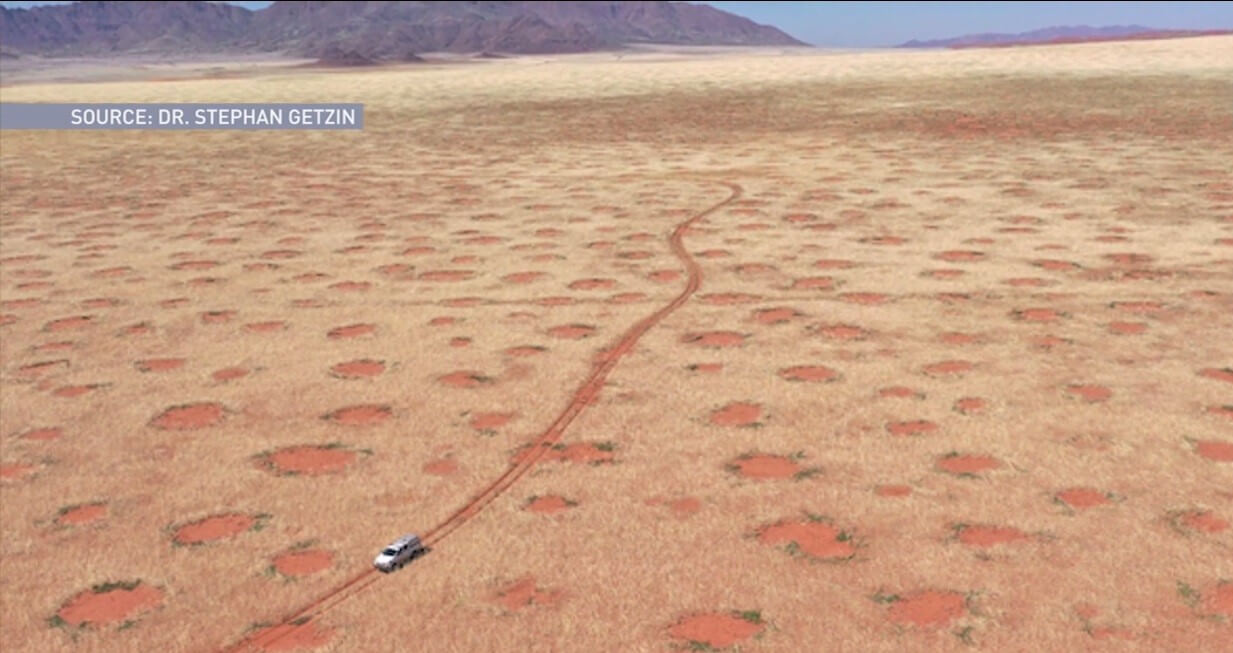In the vast expanse of the Namib Desert, an enigmatic phenomenon known as the “Fairy Circle” has intrigued scientists and nature enthusiasts for years.
These mysterious formations, numbering in the millions, have sparked various theories about their origin and purpose. In this article, we will delve into the latest hypothesis that sheds new light on these peculiar natural wonders.
In a groundbreaking discovery, fairy circles, once exclusive to Southern Africa’s Namib Desert and the Australian outback, have emerged as a global phenomenon.
Leveraging the power of artificial intelligence, a recent study has unveiled vegetation patterns akin to fairy circles in numerous new locations spanning 15 countries across three continents.
This revelation promises to offer invaluable insights into the enigmatic world of fairy circles and their formation on a worldwide scale.
Exploring New Frontiers with AI
The study, featured in the Proceedings of the National Academy of Sciences, harnessed high-resolution satellite imagery from arid regions worldwide, employing a neural network—a type of AI with a brain-like data processing capability.
Dr. Emilio Guirado, the lead author and a data scientist at the University of Alicante in Spain, emphasized, “The use of artificial intelligence models on satellite imagery is the first of its kind on such a large scale for detecting fairy-circle-like patterns.”
Identifying Potential Fairy Circle Sites
Initially, the researchers trained the neural network by feeding it over 15,000 satellite images from Namibia and Australia, half of which contained fairy circles.
Subsequently, the AI was presented with a dataset of approximately 575,000 land plots worldwide, each covering about 2.5 acres. The neural network meticulously scrutinized the vegetation in these images, identifying recurring circular patterns resembling known fairy circles.
It assessed their sizes, shapes, locations, pattern densities, and distributions.
However, it’s crucial to note that this analysis necessitated human intervention. Guirado explained that they manually excluded certain artificial and natural structures that did not align with the characteristics of fairy circles, considering the context of the area.
Global Distribution of Circular Patterns
The outcomes of this study revealed 263 arid locations worldwide exhibiting circular patterns akin to fairy circles in Namibia and Australia.
These enigmatic formations were dispersed across Africa, including the Sahel, Western Sahara, and the Horn of Africa. Moreover, they appeared in Madagascar, parts of Midwestern Asia, central Australia, and the Southwest region.
Defining Fairy Circles
While fairy circles possess a distinctive appearance characterized by repeated barren spots, they are not the sole natural phenomenon responsible for such patterns in landscapes.
Dr. Stephan Getzin, a researcher at the University of Göttingen in Germany who previously defined fairy circles, noted that what sets them apart is the highly organized arrangement of these circles.
He emphasizes that fairy circles form a “spatially periodic” pattern, making them notably more ordered compared to other patterns, a criterion not met by the patterns discovered in this study.
Nonetheless, there is no universally accepted definition of fairy circles, as acknowledged by Guirado. The study authors determined potential fairy circles by referencing guidelines established across various published studies, which suggested that the spatial patterns in both old and new fairy circles remained virtually identical.
Validating the Findings
Dr. Fiona Walsh, an ethnoecologist at the University of Western Australia, offered insights into the study’s findings. She found that the pattern of distribution in Australia corresponded with previous research.
Her team’s work, conducted in collaboration with indigenous communities, revealed that termite activity played a vital role in the formation of fairy circles in Australia.
Indigenous people had recognized and understood these patterns for generations, emphasizing the significance of termites in shaping these landscapes.
Unraveling the Mystery of Fairy Circles
Traditionally, it was believed that fairy circles were the result of termite activity, with these insects munching on the desert grass and creating distinctive circular patterns.
Another theory suggested that the plants themselves somehow orchestrated their growth into these intriguing formations. However, a recent breakthrough theory suggests a connection between these circles and the desert’s unique weather patterns.
The Namib Desert is renowned for its arid climate, characterized by approximately 300 days of relentless sunshine and dry winds. However, an unusual turn of events occurred in 2020 when an unexpected deluge of rain descended upon the desert.
This unusual weather event brought 228 millimeters of rainfall to the parched land. The consequence was astonishing—the once barren landscape transformed into a vibrant, emerald green expanse, with one notable exception: the Fairy Circles.
Approximately ten days following the rainfall, a perplexing phenomenon unfolded. The grass within the fairy circles began to wither and die, contrasting starkly with the lush greenery that thrived just beyond their confines.
This rapid deterioration continued, and by the twentieth day, the grass within the circles had succumbed entirely to the harsh conditions. Strikingly, there was no evidence of termite activity anywhere in sight, challenging the conventional explanation.
The latest theory postulates that fairy circles might serve as an ingenious adaptation by the desert grass to endure the relentless heat of their arid habitat.
In the scorching desert climate, grass faces a constant battle against water loss. To counteract this, it is believed that the grass within the fairy circles acts as an “ecosystem engineer.” These circles may create small soil moisture vacuums around their root systems, drawing precious water toward them.
This innovative theory suggests that the fairy circles are not merely a random natural occurrence but rather a survival strategy employed by the tenacious desert grass.
By concentrating water resources within these circles, the grass within them gains a crucial advantage, enabling it to thrive in the unforgiving Namib Desert environment.
In conclusion, the enigmatic fairy circles of the Namib Desert have long been a source of fascination and curiosity. While previous explanations leaned towards termite activity or plant self-organization, a new hypothesis points to these circles as nature’s response to the challenging desert climate.
These formations may be a testament to the resilience and adaptability of life in even the harshest of environments, where every drop of water can mean the difference between survival and desolation.
As scientists continue to unravel the secrets of the Namib Desert’s fairy circles, one thing remains clear: nature’s ingenuity knows no bounds.
#NamibDesert #FairyCircles #MysteryUnveiled #NatureWonders #DesertPatterns #NamibiaExploration #EcosystemMysteries #NaturalPhenomenon #EnvironmentalDiscovery



























Great wordpress blog here.. It’s hard to find quality writing like yours these days. I really appreciate people like you! take care
Loving the information on this website , you have done outstanding job on the content.
Do you have a spam problem on this site; I also am a blogger, and I was wanting to know your situation; we have created some nice procedures and we are looking to swap techniques with others, be sure to shoot me an email if interested.
Way cool, some valid points! I appreciate you making this article available, the rest of the site is also high quality. Have a fun.
I like this site because so much utile material on here : D.
You can certainly see your expertise in the work you write. The world hopes for even more passionate writers like you who are not afraid to say how they believe. Always follow your heart.
Its wonderful as your other blog posts : D, regards for posting. “A single day is enough to make us a little larger.” by Paul Klee.
I?¦ve been exploring for a bit for any high quality articles or weblog posts on this sort of area . Exploring in Yahoo I finally stumbled upon this website. Studying this information So i?¦m happy to express that I have a very excellent uncanny feeling I discovered exactly what I needed. I such a lot definitely will make certain to don?¦t disregard this web site and provides it a look on a constant basis.
I do agree with all the ideas you have presented in your post. They’re very convincing and will definitely work. Still, the posts are very short for starters. Could you please extend them a little from next time? Thanks for the post.
Hi! I’m at work surfing around your blog from my new apple iphone! Just wanted to say I love reading through your blog and look forward to all your posts! Keep up the excellent work!
Excellent beat ! I would like to apprentice while you amend your website, how could i subscribe for a blog website? The account helped me a acceptable deal. I had been a little bit acquainted of this your broadcast offered bright clear concept
Yeah bookmaking this wasn’t a speculative conclusion great post! .
Those are yours alright! . We at least need to get these people stealing images to start blogging! They probably just did a image search and grabbed them. They look good though!
I’d should check with you here. Which isn’t something I often do! I get pleasure from reading a submit that may make individuals think. Additionally, thanks for allowing me to comment!
Well I really liked studying it. This tip procured by you is very effective for good planning.
Very interesting information!Perfect just what I was looking for! “I meant what I said, and I said what I meant. An elephant’s faithful, one hundred percent.” by Dr. Seuss.